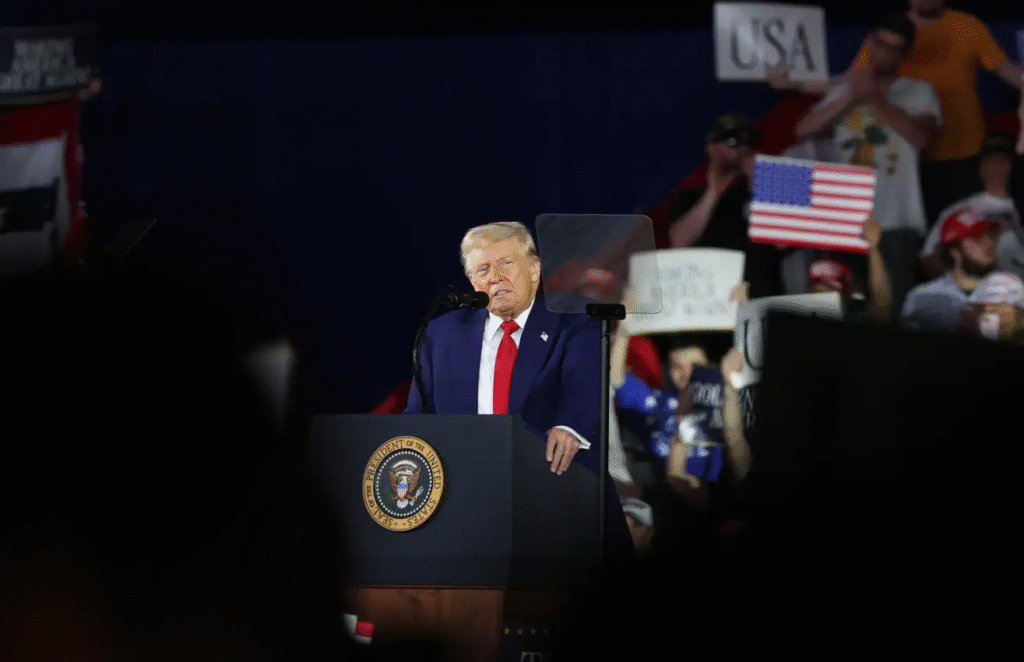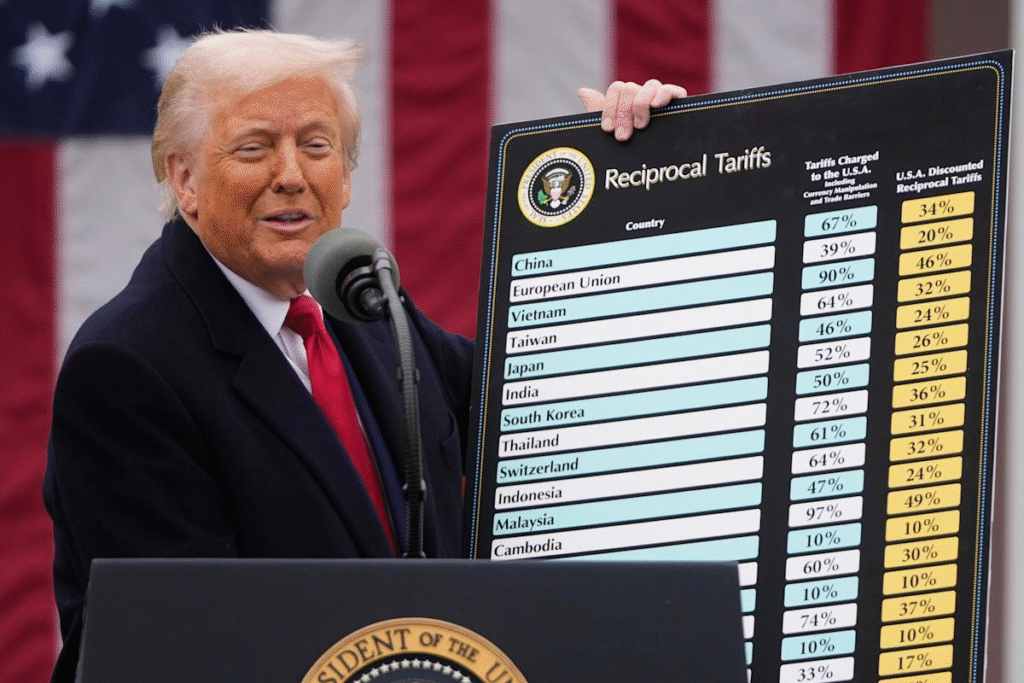Trump Blames Biden as U.S. Economy Shrinks
The U.S. economy shrank by 0.3% in the first quarter of 2025. It’s the first decline in three years, according to the Commerce Department’s Bureau of Economic Analysis.

The drop, reported on April 30, was largely due to a massive import surge. Businesses rushed to stockpile goods ahead of President Donald Trump’s sweeping tariffs.
This trade spike has muddied the economic picture and raised fears of a coming recession. Trump dismissed the contraction, saying it had “nothing to do” with his policies. Instead, he blamed Joe Biden and urged Americans to “be patient.” But what’s really behind the stumble, and is Trump’s story accurate?
A Tariff-Fueled Trade Frenzy
The contraction comes mostly from Trump’s aggressive trade agenda, which has dominated his first 100 days in office.
Starting in January 2025, Trump announced steep tariffs on imports. The targets included China, Mexico, and Canada. Some tariffs went as high as 25%. His goal was to boost domestic manufacturing by making foreign goods more expensive.
However, the move sparked panic among businesses and consumers. Fearing price hikes, many rushed to import goods before the tariffs took effect in early April. As a result, imports jumped 50.9%—the biggest surge in decades.
That spike widened the trade deficit to a record $162 billion in March. Because imports subtract from GDP, the deficit weighed heavily on growth.
Consumer spending, which makes up two-thirds of the economy, grew just 1.8%. That’s down from 4% the previous quarter.

Trump Blames Biden as U.S. Economy Shrinks
Federal spending also fell by 5.1%, adding more pressure. Still, not all the data was bad. Consumption and business investment remained solid, suggesting the economy isn’t collapsing.
Even so, the import surge skewed the GDP report. It’s now harder to judge the economy’s true health. Some economists believe that without the trade distortion, GDP might have grown.
Blaming Biden, Defending Tariffs
Trump addressed the GDP report on April 30 from the White House South Lawn. He was hosting the NFL champion Philadelphia Eagles at the time.
He insisted the downturn had “nothing to do with tariffs.” Instead, he blamed Biden’s economic legacy. “We inherited a mess,” Trump said. He claimed his trade strategy would help in the long run.
Trump asked Americans to “be patient” as tariffs reshape global trade. Peter Navarro, his senior trade adviser, agreed. He said the drop reflected businesses making a smart move to import goods early.
Democrats quickly used the report to attack Trump’s policies. Senate Minority Leader Chuck Schumer accused Trump of “running the economy into the ground.” He called for the president to fire his economic team.
Meanwhile, Senate Majority Leader John Thune defended Trump. He said tariffs needed time to work. Thune also pointed to a GOP plan for tax cuts and more defense spending as a possible fix.
Is Trump Right? What the Data Says
Trump’s claim that tariffs didn’t cause the contraction is misleading. The data shows otherwise. The import surge, driven by fear of tariffs, was the main drag on GDP.
S&P Global Ratings noted the GDP figure was “significantly influenced by the frontloading of imports.” That’s a direct result of Trump’s trade actions.
Economist Harry Chambers from Capital Economics warned that the second quarter could be worse. Once stockpiles are full, businesses may cut back sharply.
The trade deficit’s record expansion also contradicts Trump’s claim that tariffs would reduce it. He has often called the deficit a “national emergency.”
Still, Trump’s point about inherited problems holds some truth. The economy was already dealing with high inflation, which hit 3.7% in the first quarter. Global supply chain issues from the pandemic also linger.
But Trump’s tariffs have added more uncertainty. Carmakers like Stellantis and Mercedes-Benz have suspended 2025 forecasts, citing supply fears. Consumer sentiment also plunged 32% in April. It’s now at its lowest level since the 1990 recession. Americans are clearly worried about rising prices and instability.
While Trump argues that tariffs will help U.S. manufacturing, many analysts see risks. They warn the policy could lead to stagflation—high inflation combined with slow growth.
Investigations and What Trump’s Really Doing
No formal probes into the GDP drop have begun. Still, analysts and watchdogs are examining Trump’s trade policy closely.
The International Monetary Fund and Goldman Sachs have issued warnings. They say tariffs could trigger a global trade slowdown. That would hurt U.S. jobs and drive prices even higher.
Trump’s strategy goes beyond tariffs. He’s also pushed for federal layoffs and mass deportations of undocumented migrants. Both moves could further weaken economic activity.
After industry pressure, his administration has softened some auto tariffs. That shift shows some flexibility amid market volatility.
For example, General Motors pulled its 2025 forecast despite strong sales. The company cited tariff uncertainty. Meanwhile, Trump’s team is working on trade deals with Asian nations. As of April 30, the White House reported some progress.
Still, the broader strategy remains risky. Tariffs are raising costs for companies and consumers. So far, they’ve failed to deliver real economic gains.
The first-quarter GDP drop reflects the fallout from Trump’s rushed tariff policy—not just Biden’s legacy. Some economic fundamentals remain strong. But the data doesn’t support Trump’s claim that tariffs had no role in the decline.
As economists and watchdogs dig deeper into his trade agenda, the months ahead will be crucial. Trump’s challenge now is to prove that his bold strategy can lead to growth and not recession.


 Fan Falls from Clemente Wall During Pirates-Cubs Game
Fan Falls from Clemente Wall During Pirates-Cubs Game  India Closes Airspace to Pakistan
India Closes Airspace to Pakistan  Massive Wildfire Rages Near Jerusalem
Massive Wildfire Rages Near Jerusalem  Popular Content Creator Misha Agarwal Dies by Suicide
Popular Content Creator Misha Agarwal Dies by Suicide  Trump Administration Revokes 4000 Student Visas
Trump Administration Revokes 4000 Student Visas  Mark Carney Declares ‘American Betrayal’ in Victory Speech
Mark Carney Declares ‘American Betrayal’ in Victory Speech